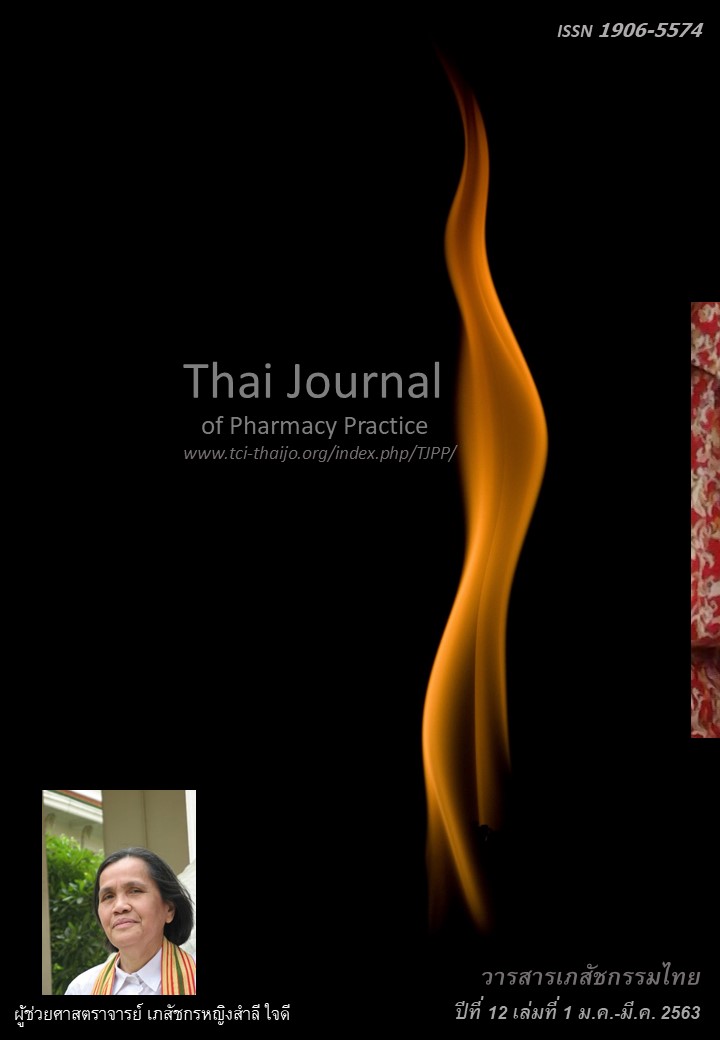ผลของการใช้แนวปฏิบัติการให้อาหารทางหลอดเลือดดำต่อการเพิ่มการเจริญเติบโต ในทารกเกิดก่อนกำหนดน้ำหนักตัวน้อยมากระหว่างรักษาตัวในโรงพยาบาล
Main Article Content
บทคัดย่อ
วัตถุประสงค์: เพื่อประเมินผลการใช้แนวปฏิบัติของการให้อาหารทางหลอดเลือดดำ (parenteral nutrition protocol: (PN protocol) ที่ทีมสหสาขาวิชาชีพของโรงพยาบาลพุทธโสธรได้ร่วมกันพัฒนาขึ้นเพื่อช่วยเพิ่มการเจริญเติบโตในทารกเกิดก่อนกำหนดน้ำหนักตัวน้อยมาก (very low birth weight preterm infants: VLBWPIs) ที่มารับการรักษาในโรงพยาบาล วิธีการ: การศึกษาเป็นการวิจัยแบบไปข้างหน้าโดยเปรียบเทียบการเจริญเติบโตในทารกเกิดก่อนกำหนดกลุ่มทดลอง 20 รายที่ได้รับ PN protocol ที่พัฒนาขึ้น และทารกเกิดก่อนกำหนดในกลุ่มเปรียบเทียบ 22 รายที่ได้รับอาหารทางหลอดเลือดดำตามแนวทางเดิมในอดีต ผู้วิจัยบันทึกการเจริญเติบโตของทารกสัปดาห์ละครั้งจากข้อมูลในเวชระเบียนของผู้ป่วยตั้งแต่แรกเกิดจนทารกมีอายุเทียบเท่าอายุในครรภ์ 37 สัปดาห์ ผลการวิจัย: ทารกในกลุ่มทดลองมีน้ำหนักตัวเฉลี่ยเพิ่มขึ้นในสัปดาห์ที่สองและสามหลังเกิดมากกว่ากลุ่มเปรียบเทียบอย่างมีนัยสำคัญทางสถิติ (110 และ 7 กรัม, P=0.04 และ 245 และ 107 กรัม, P<0.001 ตามลำดับ) นอกจากนี้ทารกเกิดก่อนกำหนดในกลุ่มทดลองที่มีน้ำหนักตัวผ่านเกณฑ์เมื่ออายุ 37 สัปดาห์ มีจำนวนมากกว่ากลุ่มเปรียบเทียบอย่างมีนัยสำคัญทางสถิติ (8 และ 2 ราย, P=0.03) แต่ไม่พบความแตกต่างอย่างมีนัยสำคัญทางสถิติของจำนวนทารกที่มีความยาวลำตัวและเส้นรอบวงศีรษะผ่านเกณฑ์ระหว่างสองกลุ่ม สรุป: การใช้ PN protocol ที่พัฒนาขึ้นนี้ช่วยเพิ่มน้ำหนักตัวในทารกเกิดก่อนกำหนดน้ำหนักตัวน้อยมากระหว่างนอนโรงพยาบาล ทั้งนี้ควรประเมินการเจริญเติบโต รวมทั้งอาหารที่ได้รับของทารกกลุ่มนี้อย่างต่อเนื่องหลังจำหน่ายออกจากโรงพยาบาล
Article Details
ผลการวิจัยและความคิดเห็นที่ปรากฏในบทความถือเป็นความคิดเห็นและอยู่ในความรับผิดชอบของผู้นิพนธ์ มิใช่ความเห็นหรือความรับผิดชอบของกองบรรณาธิการ หรือคณะเภสัชศาสตร์ มหาวิทยาลัยสงขลานครินทร์ ทั้งนี้ไม่รวมความผิดพลาดอันเกิดจากการพิมพ์ บทความที่ได้รับการเผยแพร่โดยวารสารเภสัชกรรมไทยถือเป็นสิทธิ์ของวารสารฯ
เอกสารอ้างอิง
2. Fanaroff AA, Stoll BJ, Wright LL, Carlo WA, Ehrenk ranz RA, Starh AR, et al. Trend in neonatal morbidity and mortality of very low birth weight infants. Am J Obstet 2007; 196: 147-8.
3. Ruegger C, Hegglin M, Adams M. Population based trends in mortality, morbidity and treatment for very preterm and very low birthweight infants over 12 years. BMC Pediatr 2012; 12: 17.
4. De Curtis M, Rigo J. Extrauterine growth restriction in very-low-birthweight infants. Acta Pediatr 2004; 93: 1563-8.
5. Griffin IJ, Tancredi DJ, Bertino E, Lee HC, Profit J. Postnatal growth failure in very low birthweight infants born between 2005 and 2012. Arch Dis Child Fetal Neonatal Ed 2016; 101: F50-5.
6. McLeod G, Sherriff J, Patole S. Post-discharge nutrition for high-risk preterm neonates. In: Patole S, editors. Nutrition for the preterm neonate: a clinical perspectives. London: Springer; 2013. p.173-85.
7. Suppo LM, Rugolo S. Growth and developmental outcomes of the extremely preterm infant. J Pediatr 2005; 81(Suppl 1): S101-10.
8. Euser AM, de Wit CC, Finken MJ, Rijken M, Wit JM. Growth of preterm born children. Horm Res Pediatr 2008; 70: 319-28.
9. Dusick AM, Poindexter BB, Ehrenkranz RA, Lemons JA. Growth failure in preterm infant: can we catch up? Semin Perinatol 2003; 27: 302-10.
10. William W. Aggressive nutrition of the preterm infant. Curr Pediatr Rep 2013; 1: doi:10.1007/s40124-013-0026-4.
11. Su BH. Optimizing nutrition in preterm infants. Pediatr Neonataol 2014; 55: 5-13.
12. Morgan C. Early amino acid in very preterm infants: too little, too late or too much, too soon? Semin Fetal Neonatal Med 2013; 18: 160-5.
13. Lee BS. Nutritional strategy of early amino acid administration in very low birth weight infants. Korean J Pediatr 2015; 58: 77-83.
14. Ming-Yi L, Yi-Yin C, Shu-Hui H, Yu-Kuei C, Sue-Joan C. The Influence of aggressive parenteral nutrition to preterm and very low birth weight infants. Glob Pediatr Health 2015; 2: doi: 10.1177/2333794 X14567192.
15. Jadhav P, Parimi PS, Kalhan SC. Parenteral amino acid and metabolic acidosis in premature infants. J
Parenter Enteral Nutr 2007; 31: 278-83.
16. Brener Dik PH, Gallrtti MF, Bacigalupo LT, Fernandez JS, Mariani G. Hypercalcemia and hypophosphatemia among preterm infants receiving aggressive parenteral nutrition. Arch Argent Pediatr 2018; 116: e371-7.
17. Birgin T, Deniz H, Zeliha O, Bilin C, Hande G. An aggressive nutrition protocol improves growth in preterm infants. Turk J Pediatr 2015; 57: 236-41.
18. Miller M, Vidya R, Rastogi D, Bhutada A, Rastogi S. From parenteral to enteral nutrition: a nutrition-based approach to evaluating postnatal growth failure in preterm infants. J Parenter Enter Nutr 2014; 38: 489-97.
19. Fenton TR, Kim JH. A systematic review and meta-analysis to revise the Fenton growth chart for preterm infants. BMC Pediatr 2013; 13: 59.
20. Committee on Fetus and Newborn. Age terminology during the perinatal period. Pediatrics 2004; 114: 1362-4.
21. Hediger ML, Luke B, Gonzalez-Quintero VH, Martin D, Nugent C, Witter FR, et al. Fetal growth rate and very preterm delivery of twins. Am J Obstet Gynecol 2005; 193: 1498-507.
22. Beiguelman B, Colletto G, Franchi-Pinto C, Krieger H. Birth weight of twins: the fetal growth patterns of twins and singletons. Genet Mol Biol 1998; 21: doi: 10.1590/S1415-47571998000100025.
23. Joosten K, Embleton N, Yan W, Senterre, the ESPGHAN/ESPEN/ESPR/CSPEN working group on pediatric parenteral nutrition.ESPGHAN/ESPEN/ES PRCSPEN guideline on pediatric parenteral nutrition : energy. Clin Nutr 2018; 37: 2309-14.
24. Johannes B, Vergilio C, Dominique D, the ESPGH AN/ESPEN/ESPR/CSPEN working group on pedia tric parenteral nutrition. ESPGHAN/ESPEN/ ESPR/ CSPEN guideline on pediatric parenteral nutrition: amino acids. Clin Nutr 2018; 37: 2315-23.
25. Alexandre L, Natasa FM, Olivier G, Chris HP, Jennifer W, Bert hold K, et al. ESPGHAN/ESPEN/ES PR/CSPEN guideline on pediatric parenteral nutrition: lipids. Clin Nutr 2018; 37: 2324-36.
26. Gidrewicz DA, Fenton TR. A systematic review and meta-analysis of the nutrient content of preterm and term breast milk. BMC Pediatr 2014; 14: 216.
27. Boyce C, Watson M, Lazidis J, Reeve S, Dods K, Simmer K, et al. Preterm human milk composition: a systematic literature review. Br J Nutr 2016; 116: 1033-45.
28. Agostoni C, Buonocore G, Carnielli VP, Curtis M, Darmaun D, Decsi T, et al. Enteral nutrient supply for preterm infants: commentary from the european society for pediatric gastroenterology, hepatology, and nutrition committee on nutrition. J Parenter Gastr Nutr 2010; 50: 85-9.
29. Joy NW, Genevieve C, Kristen W. Physiological weight loss in breastfed neonate: a systematic review. Open Med 2008; 2: e99-110.
30. Tagare A, Walawalker M, Vaidya U. Aggressive parenteral nutrition in sick very low birth weight babies: a randomized controlled trial. Indian Pediatr 2013; 50: 954-6.
31. Helen EM, Mark JJ, Alison AL, Victoria RC. Early parenteral nutrition and growth outcome in preterm infants: a systematic review and meta-analysis. Am J Clin Nutr 2013; 97: 816-26.
32. Roggero P, Gianni ML, Liotto F, Morniroli D, Mosca F. Small for gestational age preterm infants: nutritional strategies and quality of growth after discharge. J Matern Fetal Neonatal Med 2011; Suppl 1: 144-6.
33. Casey PH. Growth of low birth weight preterm children. Semin Perinatol 2008; 32: 20-7.


